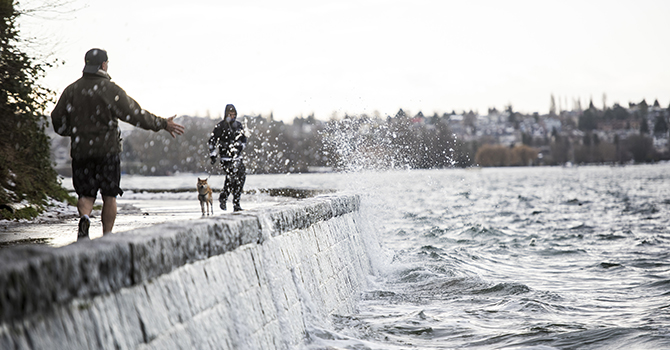
 City Council commits to Healthy Waters Plan for Vancouver
City Council commits to Healthy Waters Plan for Vancouver
As we look to the future of Vancouver’s water infrastructure, we are confident that the steps we take today will lead to a long-lasting and positive environmental legacy.
Mayor Ken Sim
Today, Council approved a key milestone in the development of our Healthy Waters Plan, with the confirmation of the plan’s guiding principles, goal areas, and objectives.
Council recently approved a 70% increase in investments in our sewer and drainage systems totalling $656 million over the next four years. The Healthy Waters Plan will be vital in cost-effectively addressing pollution from combined sewer overflows and rainwater runoff, renewing aging infrastructure, enabling housing and growth, and responding to climate change through investments that include nature-based solutions like green rainwater infrastructure.
Like many aging cities, Vancouver has a legacy of combined sewer pipes that convey rainwater runoff and sewage in the same pipe. Combined sewer overflows happen when these pipes are overwhelmed during rain events, and overflow into nearby receiving waters like the Burrard Inlet and False Creek. Rain becomes runoff when it flows over hard urban surfaces like roads. It can pick up chemicals and other pollutants and carry them into nearby waterways, or into our pipe system, where they end up in the ocean during combined sewer overflows.
Since the 1970s, we have been replacing combined pipes with separated pipes, and since 2010 we have been accelerating the implementation of green rainwater infrastructure. Green rainwater infrastructure uses soil and plants to capture and treat rainwater closer to where it falls, reducing the volume of rainwater entering pipes. This work is happening alongside policies and community initiatives that address pollution at the source and promote development and behaviour that reduce water use. Green rainwater infrastructure is also a core tactic of the Rain City Strategy which reimagines our design to embrace rainwater as a valued resource while setting a target of capturing and cleaning 90% of rainwater.
In October 2022, Vancouver became the first Canadian municipality to pass a United Nations Declaration on the Rights of Indigenous Peoples (UNDRIP) Strategy toward reconciliation. The xwməθkwəy̓əm (Musqueam Indian Band) and sə̓lílwətaʔɬ (Tsleil-Waututh Nation) have been key partners of the Healthy Waters Plan since inception along with 14 organizations from other levels of government and community.
Background
- Review the Healthy Waters Plan report PDF file (1.6 MB) presented to Council today on phase 1 findings
- Learn more about green rainwater infrastructure and our Rain City Strategy.
Quotes
Mayor Ken Sim
“As we look to the future of Vancouver’s water infrastructure, we are confident that the steps we take today will lead to a long-lasting and positive environmental legacy. Better infrastructure will allow us to see healthier ecosystems and safer, cleaner waterways around our city,” says Mayor Ken Sim.
Adds Mayor Sim: “The Healthy Waters Plan will help us deliver on Vancouver’s long-range growth strategy, the Vancouver Plan, while protecting the environment, and ensuring resilient and sustainable service delivery in the years to come. It also advances our commitments in the UNDRIP Strategy and the Rain City Strategy.”
Mark Mattson, President and CEO, Swim Drink Fish
"What the City of Vancouver is doing with its Healthy Waters Plan is the kind of leadership other major cities around Canada, and North America, can look at as an example of what needs to be done in addressing sewage pollution, at the root of the issue: infrastructure,” says Mark Mattson, President and CEO, Swim Drink Fish. “This type of investment encompasses public health, water quality, and understanding the importance of a healthy watershed to a community's social fabric. Swim Drink Fish is very encouraged to be part of such a strong collaboration of Indigenous nations, organizations, government and community in protecting and restoring Vancouver's waters.”